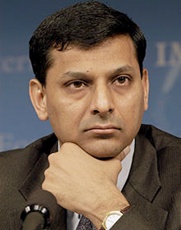RBI ups repo rate by 0.25%, but suggests no more hikes likely
28 Jan 2014
The Reserve Bank of India today unpleasantly surprised the market by raising the repo rate – a key policy rate, at which commercial banks borrow from the central bank, to 8 per cent – a 25 basis points or 0.25 per cent hike, despite lower inflation rates in December.
 The repo rate is the rate at which RBI buys government bonds from banks to meet their liquidity requirements.
The repo rate is the rate at which RBI buys government bonds from banks to meet their liquidity requirements.
RBI, however, kept the cash reserve ratio (or the amount of cash banks deposit with the RBI) of scheduled commercial banks unchanged at 4 per cent of their net demand and time deposits.
Consequently, the reverse repo rate under the liquidity adjustment facility (LAF) stands adjusted at 7.0 per cent, and the marginal standing facility (MSF) rate and the Bank Rate at 9.0 per cent.
The RBI, however, said it is actively engaged in the management of liquidity to offset frictional and structural pressures so that there is adequate credit flow to the supply side of the economy.
Liquidity conditions were impacted by the mid-December advance tax outflows after the government curtailed its spending in order to rein in mounting fiscal deficit.
In its mid-quarterly monetary policy review, RBI said that if consumer price inflation eases as projected, it does not foresee further near-term tightening of monetary policy.
Some media commentators have suggested that home loan rates may go up as a consequence. But with poor uptake of loans amid a shrunken economy, commercial banks continue to offer competitive rates despite earlier hikes in the central bank's policy rates, so this may be a 'wait and watch' situation.
At the same time, RBI cut its growth forecast to less than 5 per cent for 2013-14, even while expressing confidence if a turnaround in the broader economy in the next financial year (2014-15).
''If policy actions succeed in delivering the desired inflation outcome, real GDP growth can be expected to firm up from a little below 5 per cent in 2013-14 to a range of 5 to 6 per cent in 2014-15, with risks balanced around the central estimate of 5.5 per cent,'' RBI governor Raghuram Rajan said in the review.
The RBI's decision was driven by an expectation that the consumer price index (CPI) would remain high - an indication that India's central bank is looking to adopt a recent proposal to base its policy rate decisions on the CPI rather than the wholesale price index (WPI), commonly referred to as 'headline inflation'.
Most economists in a Reuter poll conducted last week had expected no change in rates. However, expectations for a rate hike had increased after an RBI panel proposed to make CPI the main inflation benchmark.
The CPI eased to a three-month low of 9.87 per cent in December but remains well above the central bank's policy repo rate of 7.75 per cent, and the RBI said that consumer inflation risks remain.
The RBI said CPI inflation is likely to stay above 9 per cent during the final quarter of the fiscal year that ends in March, ranging between 7.5 per cent and 8.5 per cent for the quarter that ends in March 2015, "with the balance of risks tilted on the upside".
It also said Indian economic growth is likely to fall short of its earlier projection of 5 per cent this fiscal year, but will improve to 5-6 per cent in the next financial that starts in April.
India's wholesale inflation rate eased to a five-month low of 6.16 per cent in December as prices of vegetables finally dropped after hitting record highs for about a year.
''I think this could be the last in the series of rate hikes,'' said C Rangarajan, chairman of Prime Minister's Economic Advisory Council.
Inflation
Although consumer price inflation measured in terms of the consumer price index (CPI) declined significantly on account of a decline in the prices of fruits and vegetables, it remains elevated at close to double digits, RBI noted. Moreover, inflation excluding food and fuel has also been high, especially in respect of services, indicative of wage pressures and other second round effects.
Headline inflation based on the wholesale price index (WPI) eased to a four-month low with the sharp decline in vegetable and fruit prices. Non-food manufactured products (NFMP) inflation, however, rose in December on an uptick in prices of chemicals, non-metallic minerals and paper products.
Hardening prices of services and key intermediates, rising bank credit, increase in order books, pick-up in capacity utilisation and the decline in inventories of raw materials and finished goods in relation to sales all suggest that aggregate demand pressures are still imparting an upside to overall inflation, RBI pointed out.
''It is critical to address these risks to the inflation outlook resolutely in order to stabilise and anchor inflation expectations, even while recognising the economy is weak and substantial fiscal tightening is likely in Q4,'' it added.
Economic outlook
Domestic growth is likely to see a strong pick-up with rabi sowing, industrial activity remains in contractionary mode, mainly on account of manufacturing, which declined for the second month in succession during third quarter. Consumption demand continues to weaken and lacklustre capital goods production points to stalled investment demand.
Fiscal tightening through Q3 and Q4 is likely to exacerbate the weakness in aggregate demand, it added.
RBI noted that while global economic growth is gaining traction, led by the strengthening of the US economy, it is still uneven and subdued in the euro area and Japan, and a slowdown in China seems to be underway.
Notwithstanding the boost from stronger external demand, uncertainty continues to surround the prospects for some emerging economies, with domestic fragilities getting accentuated.
Financial market contagion is a clear potential risk, RBI pointed out.







.webp)














